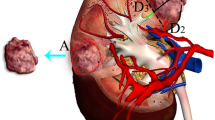Abstract
Objectives
PADUA score is a standardized anatomical classification of renal tumors proposed with the aim to objectivize the decision-making process of any urologist evaluating kidney tumors potentially suitable for nephron-sparing surgery. The system was proposed in a series of patients treated with open partial nephrectomy (PN) and was recently validated in a series of patients treated with either open or laparoscopic PN. The purpose of the present study was to validate the PADUA score in a series of consecutive patients who underwent robot-assisted PN (RPN).
Methods
We evaluated retrospectively all the MRI or CT images of 62 consecutive patients who underwent RPN for renal tumors at a nonacademic teaching institution by a single surgeon between September 2006 and November 2009.
Results
PADUA score (6–7 vs. 8–11) was correlated with warm ischemia time (WIT) (P = 0.002), console time (P = 0.001), blood loss (P = 0.009), percentage of pelvicaliceal repair (P = 0.002), and overall complications (P = 0.02). PADUA score was the only variable able to predict the risk of the overall complications (P = 0.02). PADUA score turned out to be an independent predictor of WIT >20 min in multivariable analysis (OR 5.4; P = 0.002), once adjusted for surgeon’s experience Finally, PADUA score was the only independent predictor of the need for pelvicaliceal repair (OR 3.7; P = 0.006).
Conclusions
PADUA classification was an effective tool to predict WIT and risk of perioperative complications also in patients who underwent RPN. This classification must be considered useful to improve patients counseling and selection for RPN.
Similar content being viewed by others
References
Ljungberg B, Hanbury DC, Kuczyk MA et al (2010) Renal cell carcinoma guideline. Eur Urol 58:398–406
Novick AC, Campbell SC, Belldegrun A et al (2009) Guideline for management of the clinical stage 1 renal mass. American Urological Association Web site. http://www.auanet.org/content/guidelinesand-quality-care/clinical-guidelines/mainreports/renalmass09.pdf
Ficarra V, Novara G, Secco S et al (2009) Preoperative aspects and dimensions used for an anatomical (PADUA) classification of renal tumours in patients who are candidates for nephron-sparing surgery. Eur Urol 56:786–793
Kutikov A, Uzzo RG (2009) The RENAL nephrometry score: a comprehensive standardized system for quantitating renal tumor size, location and depth. J Urol 182:844–853
Waldert M, Waalkes S, Klatte T et al (2010) External validation of the preoperative anatomical classification for prediction of complications related to nephron-sparing surgery. World J Urol 28(4):531–535
Dindo D, Demartines N, Clavien PA (2004) Classification of surgical complications: a new proposal with evaluation in a cohort of 6,336 patients and results of a survey. Ann Surg 240:205–213
Greene FL, Page D, Fleming ID et al (2002) AJCC cancer staging manual, 6th edn. Springer-Verlag, New York, NY
Eble JN, Sauter G, Epstein JI et al (2004) Pathology and genetics of tumors of the urinary system and male genital organs. World Health Organization classification of tumors. IARC Press, Lyon, France
Touijer K, Jacqmin D, Kavoussi LR et al (2010) The expanding role of partial nephrectomy: a critical analysis of indications, results, and complications. Eur Urol 57:214–222
Gill IS, Kamoi K, Aron M, Desai MM (2010) 800 laparoscopic partial nephrectomies: a single surgeon series. J Urol 183:34–42
Gettman MT, Blute ML, Chow GK et al (2004) Robotic assisted laparoscopic partial nephrectomy: technique and initial clinical experience with Da Vinci robotic system. Urology 64:914–918
Becker F, Van Poppel H, Hakenberg OW et al (2009) Assessing the impact of ischaemia time during partial nephrectomy. Eur Urol 56(4):625–634
Patel MN, Krane LS, Bhandari A et al (2010) Robotic partial nephrectomy for renal tumors larger than 4 cm. Eur Urol 57:310–316
Conflict of interest
The authors declare that they have no conflict of interest.
Author information
Authors and Affiliations
Corresponding author
Rights and permissions
About this article
Cite this article
Mottrie, A., Schatteman, P., De Wil, P. et al. Validation of the preoperative aspects and dimensions used for an anatomical (PADUA) score in a robot-assisted partial nephrectomy series. World J Urol 31, 799–804 (2013). https://doi.org/10.1007/s00345-010-0639-y
Received:
Accepted:
Published:
Issue Date:
DOI: https://doi.org/10.1007/s00345-010-0639-y



